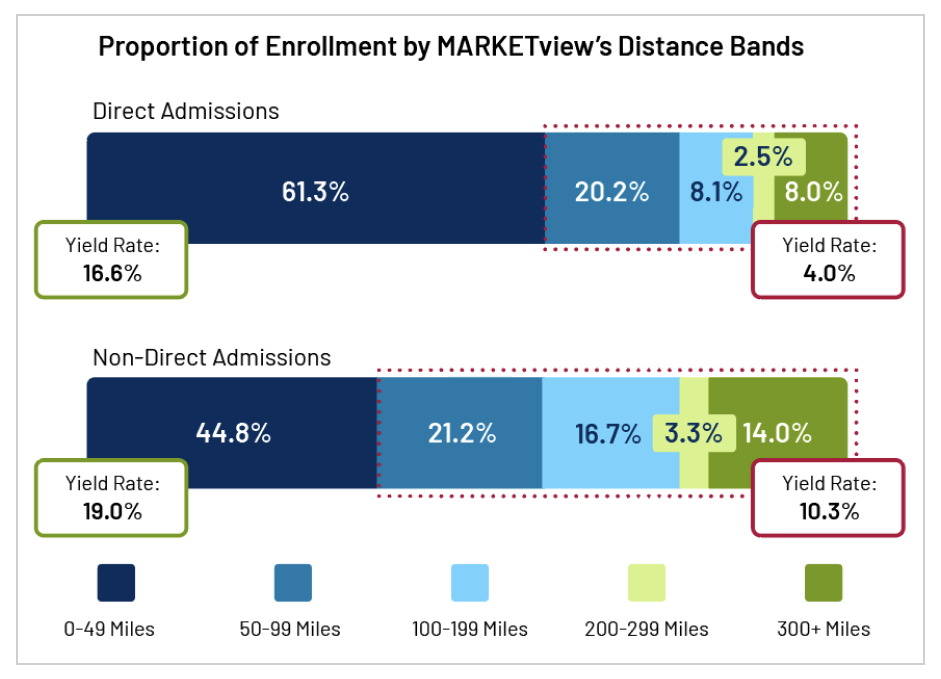The enrollment landscape can be challenging and unpredictable — from FAFSA changes to shifting student demographics and more. The constant pace of change in higher ed prompts many enrollment leaders to seek out new and creative ways to reach their goals. Enter: Direct Admissions.
To better understand the nuances of this barrier-breaking enrollment strategy, we’re launching a new series of informative blogs. For the first installment, we’ll examine MARKETview data from almost 200 partner institutions to discover what it reveals about the yield rate of Direct Admissions students in the 2024 cycle. We’ll also get insider perspectives from a few partners with hands-on Direct Admissions experience.
How Distance From Campus Influences Direct Admissions Yield
In the 2024 cycle, 14.9% of our partners used some form of Direct Admissions. MARKETview’s comparative data helped uncover a few key insights into how students who enrolled through Direct Admissions performed compared to those who enrolled through traditional channels. One standout discovery revolved around the relationship between distance from campus and yield rate.

Typically, Direct Admissions students yield about six percentage points lower than non-Direct Admissions students. But when filtering the Direct Admissions and non-Direct Admissions enrollment data through MARKETview’s Distance Bands, it showed that the yield rate for students who are less than 50 miles from campus is only 2.4 percentage points lower than students who participate in the traditional admissions process. For institutions with goals around growing their local market, Direct Admissions could be a worthy consideration. The majority (61.3%) of Direct Admissions enrollment comes from within 50 miles of campus, and the yield rate is strong (16.6%).
Reggie Hill, Vice President for Strategic Enrollment and Career Advancement at University of Missouri–St. Louis, explains how the significant increase in Direct Admissions volume at his institution is more than enough to offset the lower yield rates.
“We’re seeing, roughly, a 41% increase in admits. So, I’m sure other Direct Admissions partners are seeing maybe a 20 to 30% increase. Wouldn’t you want a 20 to 30% increase in admits with a 16% yield rate, which is only 2.4 pp lower than the control group? That’s where the value is.”
– Reggie Hill
Of course, the data did show expected yield drop-offs for Direct Admissions students the farther they live from campus. Those that were more than 50 miles away yielded at only 4.0%, compared to non-Direct Admissions students in the same distance band yielding at 10.3%. However, only 38.7% of Direct Admissions enrollment was sourced from distances beyond 50 miles.
Michelle Kowalsky Goodfellow, Associate Vice President of Enrollment Management at Western New England University, explained how despite these yield differences, there is still an upside to recruiting with Direct Admissions.
“Yes, they are yielding slightly differently, but at the same time they are yielding.”
– Michelle Kowalsky Goodfellow
Ken Woods, Vice President of Strategic Enrollment at Whittier College, added that these lower yield rates from further distance bands can still be considered a success in the big picture.
“You can’t work with them if they’re not in your funnel. Although I might get 40 kids out of North Carolina, if I yield one of those students, I’m pretty happy.”
– Ken Woods
For a deeper dive into the 2024 MARKETview Direct Admissions data, you can access our new eBook highlighting additional key insights we uncovered. If you want more expert perspectives from our Direct Admissions partners, you can download the recording of our recent panel discussion webinar. And make sure to keep an eye out for the next installment of this series, where we’ll cover Direct Admissions best practices!
Find out how MARKETview can help you reach your enrollment and revenue goals using Direct Admissions or any other decision type by scheduling a live demo with our team.
